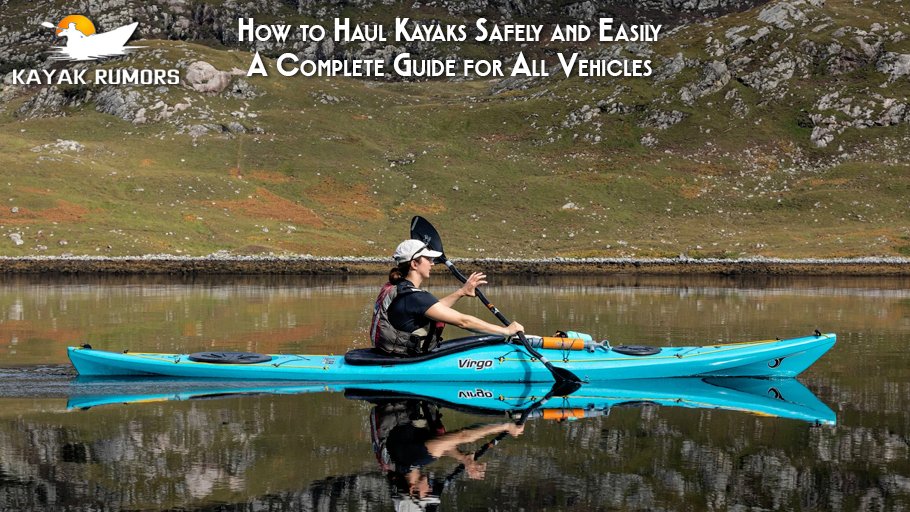Introduction: Master the Art of Hauling Kayaks
Kayaking is one of the most thrilling outdoor activities, whether you’re paddling on tranquil lakes or exploring wild rivers. However, hauling kayaks from your home to the water can be a challenge if you don’t know the best methods. In this guide, we’ll show you how to haul kayaks efficiently, ensuring your kayak remains safe and you don’t break a sweat in the process.
Understanding the best way to transport your kayak is crucial, not only for saving time and effort but also for protecting your gear. If you’re new to kayaking or looking for better ways to haul your kayak, this article has you covered. Let’s dive into the essentials.
The Ultimate Guide to Hauling Kayaks Safely
Understanding Kayak Sizes and Types
When it comes to hauling kayaks, not all kayaks are created equal. Kayaks come in various shapes, sizes, and weights, which significantly impact how you should transport them. Let’s break down the different types of kayaks:
- Recreational Kayaks – These are the most common type, typically lightweight and easy to handle. They usually range from 8 to 12 feet long.
- Touring Kayaks – Longer and sleeker, designed for longer trips. They tend to be heavier and require more secure hauling techniques.
- Fishing Kayaks – These are often wider and heavier, with more equipment. They require extra care during transport.
- Inflatable Kayaks – Lightweight and easy to fold, inflatable kayaks require different hauling methods, like using bags or carrying them in the trunk.
Understanding the size and weight of your kayak is the first step in knowing how to haul kayaks properly.
Key Factors to Consider When Hauling Kayaks
Before you start hauling, consider these factors:
- Kayak Weight: Heavier kayaks need extra support during transport.
- Length: Longer kayaks will need more space, making roof racks or trailers necessary.
- Vehicle Type: Whether you’re using a car, truck, or SUV, make sure your vehicle can accommodate the kayak.
The right hauling method depends on these key factors. It’s essential to match your kayak’s size and weight with the best transportation option to ensure it’s safely secured.
Best Methods to Haul Kayaks: From Roof Racks to Trailers
Using Roof Racks: A Common Option for Kayak Transport
One of the most popular methods for hauling kayaks is using a roof rack. If your car has a roof rack, you’re in luck—it’s one of the easiest ways to transport a kayak. Here’s what you need to know:
- Types of Roof Racks: There are several types of roof racks, including crossbars, foam blocks, and J-cradles. Crossbars are the most common, providing solid support for a kayak.
- Installation Tips: Make sure the roof rack is securely installed and the kayak is placed on it properly. You’ll need to adjust the straps so the kayak stays in place during transit.
- Pros: Roof racks are a convenient and space-efficient solution.
- Cons: They can be a hassle to load and unload, especially if the kayak is heavy or if you’re doing it alone.
Kayak Trailers: When to Use One
If you have more than one kayak to haul, or if you’re carrying a heavier model, a kayak trailer is the way to go. Trailers can accommodate multiple kayaks at once and provide more stability than roof racks.
- When to Use a Trailer: If you’re planning on taking your kayak on long trips or if you have a larger kayak, a trailer will provide more room and support.
- Types of Trailers: There are various kayak trailers, including single-kayak and multi-kayak trailers. Choose based on the number of kayaks you need to haul and the load capacity of your vehicle.
DIY Solutions: Hauling on a Budget
If you’re on a budget and don’t want to invest in roof racks or trailers, you can still haul your kayak using DIY methods. Consider these options:
- Homemade Kayak Cart: A small, portable cart can be used for short-distance hauling.
- Carrying on the Roof Without a Rack: In a pinch, you can use foam pads or pool noodles to create makeshift padding on your car’s roof.
Choosing the Right Equipment: Roof Racks, Trailers, and Beyond

Choosing the Right Roof Rack for Your Vehicle
When selecting a roof rack for your kayak, consider your vehicle’s size and your kayak’s dimensions. Here are the most common options:
- Saddle Roof Racks: These provide a secure base for your kayak and are excellent for kayaks with flat bottoms.
- J-Cradles: Ideal for longer kayaks, J-cradles secure your kayak on its side, saving roof space.
- Foam Blocks: These are cheaper and simpler, but they require more effort to strap the kayak properly.
Kayak Cradles, Pads, and Straps
Regardless of your transport method, you’ll need these essential accessories:
- Kayak Pads: These protect your kayak from scratches and dents while resting on your car.
- Straps: Invest in high-quality straps to secure your kayak. Cam-buckle straps are often preferred because they’re adjustable and hold the kayak tightly without damaging it.
Alternative Options for Hauling
If you’re hauling for a short distance or don’t want to use a roof rack, consider these alternatives:
- Truck Bed: If you have a truck, you can load the kayak directly into the bed. Use straps to secure it.
- Kayak Carts: Perfect for short hauls or launching your kayak from a dock.
Common Mistakes to Avoid When Hauling Kayaks
Incorrect Loading Techniques
Proper loading is crucial. Failing to load your kayak correctly can lead to damage or even accidents. Here’s what you should avoid:
- Overloading: Ensure that the kayak is centered and balanced. If your kayak is too far forward or backward, it can affect the car’s balance.
- Wrong Positioning: Always place the kayak in a position that minimizes wind resistance and maximizes safety.
Failure to Secure the Kayak Properly
One of the biggest mistakes is not securing the kayak tightly enough. Always use straps and check their tightness before starting your journey.
Other Transport Hazards
- Wind Effects: Wind can cause kayaks to sway during transport. If your kayak isn’t securely fastened, this can result in damage.
- Rough Roads: Driving on bumpy terrain can damage your kayak. Drive carefully and consider wrapping your kayak in additional padding for extra protection.
FAQ: How to Haul Kayaks Questions Answered
1. How do I know if my car can carry a kayak?
Make sure to check your car’s roof capacity and compare it with your kayak’s weight. Some vehicles have weight limits, so it’s essential to ensure you’re within these limits.
2. What is the best way to secure a kayak on a roof rack?
Use padded straps to secure the kayak tightly to the roof rack. Ensure it’s centered and that the straps are pulled snugly without damaging the kayak.
3. Can I haul multiple kayaks in a single vehicle?
Yes, you can haul multiple kayaks with the right equipment, such as a multi-kayak trailer or a roof rack with additional crossbars or J-cradles.
4. Do I need a trailer to haul my kayak?
Not necessarily. While a trailer is great for multiple kayaks or heavy models, you can easily haul a single kayak with a roof rack or even by placing it in a truck bed.
5. What are the safety precautions for transporting kayaks over long distances?
Check your kayak’s secure placement, avoid driving on rough roads if possible, and ensure your kayak is shielded from the elements to prevent UV damage.
Helpful Kayaking Guides You Might Also Like
Learning how to haul kayaks is just the start of your kayaking journey. If you’re looking to deepen your knowledge, check out some of our most popular and informative blogs on Kayak Rumors. These guides cover everything from fitness benefits to legal requirements and beginner tips:
- How Many Calories Does Kayaking Burn? A Complete Guide to Weight Loss on the Water
- Do You Have to Register a Kayak? What Kayak Rumors Reveal
- What Is Kayaking? A Complete Beginner-Friendly Guide from Gear to Trips
These articles are packed with simple, practical tips to help you get more out of every paddling trip.
Explore More Kayak Gear for Your Next Adventure
Looking for the best equipment to make hauling your kayak even easier? We’ve got you covered! Check out our top recommended kayak accessories, including roof racks, trailers, and straps. These products are designed to make your kayaking trips smoother and safer. Whether you’re a beginner or an experienced paddler, you’ll find the right gear to suit your needs.
Explore top-rated kayak transport solutions here!
Conclusion: Ready to Haul Your Kayak Like a Pro
Now that you know how to haul kayaks safely and effectively, you’re ready to transport your kayak with ease. Whether you use a roof rack, trailer, or a DIY solution, the key to a successful haul is choosing the right equipment, securing your kayak properly, and being aware of the conditions during transit.
At Kayak Rumors, we understand the importance of getting your kayak to the water safely. So, before your next kayaking trip, make sure you’ve followed these tips to ensure a smooth and worry-free journey.
Call to Action
Got any hauling tips or kayak transport stories? Share them with us in the comments below! And don’t forget to check out our other guides on kayak gear and maintenance. For more expert advice on everything kayaking, stay tuned to Kayak Rumors!


